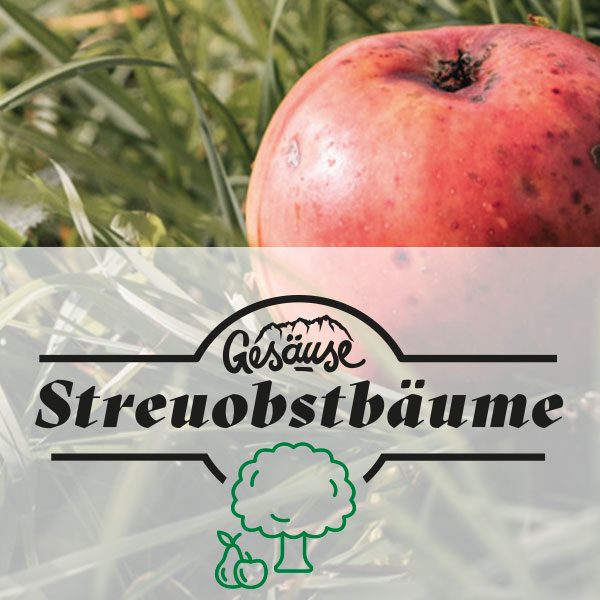Streuobst
Infos zu: Streuobstbäume | Neue alte Sorten | Sortengarten | Projekte
Streuobstbäume
Wo erhältlich?
- In unserem Verkaufsgarten:
Genussmosthof Veitlbauer
Bichl 3, 8932 St. Gallen // www.veitlbauer.at
Infos zum Verkaufsgarten beim Genussmosthof Veitlbauer:- Christian Weissensteiner:
+43 (0) 664/350 88 31
office@veitlbauer.at - oder bei unserer Ansprechpartnerin im Naturpark
Oliver Gulas-Wöhri, MSc
+43 (0) 664/88656411
o.gulas@eisenwurzen.com
- Christian Weissensteiner:
- Im Hofladen Grabnerhof:
Hall 225, 8911 Admont (außer Juli und August)
Jeden Donnerstag von 14:00 bis 16:30 Uhr
Tel.: 0664 / 404 20 37
Durch das richtige Anpflanzen verschiedener Apfel- und Birnbäume hast du fast das ganze Jahr über Obst aus deinem eigenen Garten. Vitamine zum Anbeißen, Marmeladen zum guten Start in den Tag, Saft gegen jede Durststrecke oder veredeltes Hochprozentiges für jede Feier. Ein Streuobstgarten hilft in allen Lebenslagen und zusätzlich ist er noch der ideale Schattenspender. Er begleitet dich und deinen Garten ein Leben lang — das freut auch zum Beispiel deine Bienen, Vögel und viele mehr. Also auch noch etwas Gutes tun für die Natur…
Unser Obstsalat
Unsere Größen
Aufgepasst! Groß werden unsere Bäume mit richtiger Pflege alle, wo die Höhe der Krone ansetzt ist jedoch verschieden. Da gibt es aber eine einfache Bauernregel:
„Will der Bauer noch auf der Wiese mit dem Traktor mähen, sollt er schon einen Hochstamm aussäen. Denn beim Busch, gibt es mit dem Traktor einen Tusch.“

Neues Altes
5 Gründe für ein klares Bekenntnis zu Streuobst & alten Obstsorten
Streuobstwiesen sind auch in der Steirischen Eisenwurzen und im Gesäuse schon „fast“ immer da gewesen. Sie prägen auch unsere Landschaft zwischen St. Gallen und Wildalpen und sind neben Wäldern, naturnahen Flüssen und Almen nicht mehr wegzudenken. Uns als Naturpark sind derzeit über 150 Apfelsorten und über 35 Birnensorten bekannt. Eine Vielfalt die wir mit euch gemeinsam auch für zukünftige Generationen erhalten möchten.
Warum? Unsere 5 Gründe:
- Der Geschmack
Hier findet sich bereits die Streuobstvielfalt zum Genießen: Ein mehr oder weniger harmonisches Zusammenspiel aus Zucker, Säure und Gerbstoffen ermöglich eine Vielzahl an Nutzungen. Tafelobst, Strudel, Most, Schnaps und vieles mehr. - Biodiversität & Landschaftsbild
Streuobstwiesen gelten als die artenreichsten Lebensräume unserer Kulturlandschaft. Bis zu 5.000 Tier-, Pflanzen- und Pilzarten tummeln sich hier. Über Jahrhunderte versorgten sie unsere Vorfahren – ohne synthetischen Pflanzenschutz und Dünger – mit den Früchten aus dem Garten Eden. - Unsere Gesundheit
Kinder wachsen in einer sterilen Umgebung auf, die Anzahl der Allergien nimmt drastisch zu. Der klinisch saubere Apfel passt in dieses Gesamtbild. Wo sind die Zeiten, als man den Gravensteiner im Garten vom Boden aufsammelte und einfach abgebissen hat. Streuobst ist gesund, weil voll von hunderten Vitalstoffen und weil es vollreif gegessen wird. - Klimawandel & Regionalität
In Zeiten des Klimawandels ist eine regionale Selbstversorgung mit kurzen Transportwegen das Gebot der Stunde. Zudem können nur durch die robusten Eigenschaften der „alten Sorten“ neue, an den Klimawandel angepasste Sorten, gezüchtet werden. - Fairness
LandwirtInnen stellen heute berechtigt die Frage, warum sie sich angesichts von Niedrigstpreisen überhaupt noch mit Streuobst befassen sollen. „Sammeln Sie doch selbst einmal 1.000 Kilo auf, um dann 40 Euro zu bekommen“ ist der legitime Vorwurf. Diese Fairness wollen wir in gewissen Rahmen wieder verbessern – mit unseren Partnern vor Ort. Was wir anbieten steht gleich auf der nächsten Seite.
Text von Mag. Alois Wilfing, OIKOS im Auftrag von Naturparke Steiermark
Frühjahr und Herbst
Unsere Profis für Obstbaumschnitt:
- Norbert Haase: 0676/3086165
- Rainer Tramberger: 0664/3566772
Für den Herbst
Lohnpressen, Obstkauf, Obstbaumverkauf und vieles mehr:
- Der Genussmosthof Veitlbauer ist unser regionaler Gesäuse Partner in Sachen Streuobst. Für dein Obst gibt es hier einen fairen Preis: 0,30 € pro kg.
- Kontakt: Genussmosthof Veitlbauer
Susanne & Christian Weissensteiner
A-8932 St. Gallen, Bichl 3
0664/3508831
Spätsommer und Herbst
Schon immer neugierig gewesen, welche Sorten in deinem Obstgarten stehen? Wir sind regelmäßig mit Pommologen (so heißen die „Obstbestimmungskundler“) unterwegs um regionale Sorten zu bestimmen. So konnten wir neue „alte“ Streuobstsorten wiederentdecken und für die Zukunft erhalten: Eisenwurzenbirne, Gesäuseapfel oder beispielsweise Salzataler Raftingapfel.
Das ganze Jahr
Wir, der Natur- und Geopark veranstalten das ganze Jahr über Veranstaltungen rund um Streuobst: Schnittkurse, Bestimmungskurse, Pflegetage, und vieles mehr. Zum Eintauchen in die Streuobstwelt gibt es Sortengärten in den Gemeinden Wildalpen und Landl sowie beim Veitlbauer.
Neugierig geworden? Einfach melden im Naturparkbüro.
Streuobst-Sortengarten
In Wildalpen, Gams und Palfau
Obstgärten im Ortsteil Hopfgarten in der Naturparkgemeinde Wildalpen sowie in den Ortsteilen Palfau und Gams der Naturparkgemeinde Landl dienen zur Erhaltung alter und seltener Obstsorten (vorwiegend Apfel und Birnen) aus Streuobstbeständen des Natur- und Geopark Steirische Eisenwurzen. Der Naturpark hat sich in Zusammenarbeit mit den Österr. Bundesforsten AG, Forstbetrieb Steiermark, zum Ziel gesetzt in Wildalpen und Landl die unterschiedlichen Sorten in diesem sogenannten Generhaltungsgarten für zukünftige Generationen zu erhalten. Weiterführende Informationen zu den Sorten finden Sie vor Ort. Die frei zugänglichen Obstgärten sind auch ideal bei einem Spaziergang erreichbar. Augen auf – überall kann man entlang des Weges Streuobstwiesen entdecken.





